The 35th interview in Le Figaro Vin’s series finds us once more in Champagne to meet Vincent Chaperon, #16 of France’s 50 best winemakers and cellar master of the emblematic champagne house: “I have quite an extreme nature”.
With his slender and athletic physique, preppy haircut, sharp gaze framed by thick-rimmed eyeglasses, and perfect diction, Vincent Chaperon is the kind of person one could easily find annoying, as he seems to have been unfairly graced with every enviable quality. But digging deeper, one might also sense a darker part, an urgency, and an eagerness to do well that is at odds with the hazardous conditions of a career that is at the mercy of its environment. Yet it is this tension, this fear of failure, that has crowned the young cellar master with success after success, where others might have settled for safety. “My time at Dom Pérignon has been something of a Bildungsroman: I was plucked straight out of school by my predecessor, Philippe Coulon (who passed in June 2023, ed.), and then raised in the maison” he recalls. “Despite my Bordeaux upbringing, to which I remain very attached, my adult life took shape in Champagne.”
Following a brief trip abroad, he was named oenologist in 2000, forming a virtually symbiotic duo with his predecessor Richard Geoffroy. “I arrived here with many expectations and ambitions, I wanted to prove something, and I had the chance to be inspired by people whom I loved very much, such as Richard, who helped me make the right decisions at times when I was growing impatient.”
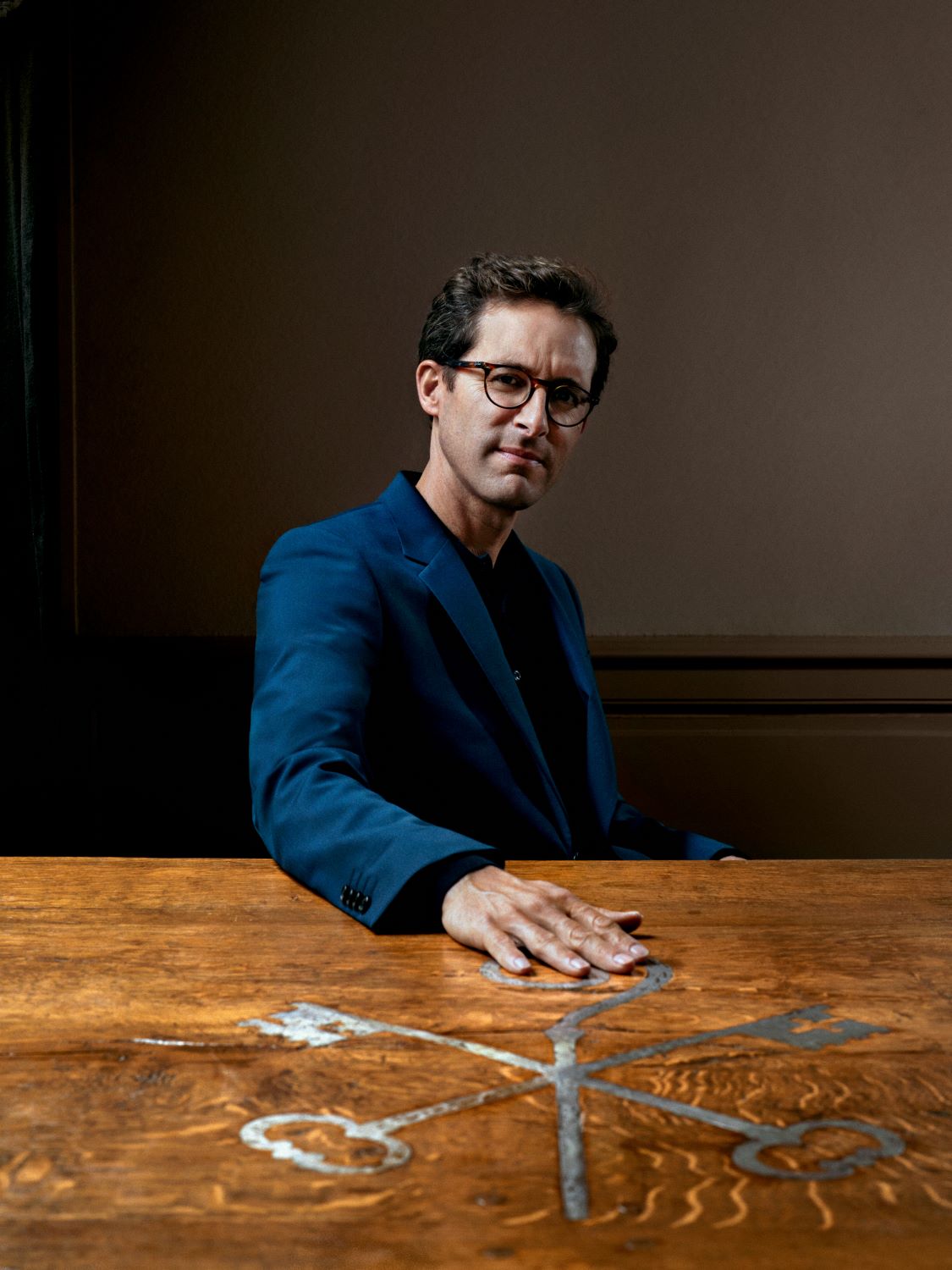
This restraint bore its fruits: in 2017, the maison announced that he would be appointed cellar master the following year. “That day, I walked down the same hallways I always did, but everything had a different dimension, I looked back at the path that brought me here. It was an incredibly emotional moment.”
For the past five years, Vincent Chaperon has followed his ambition to fully embrace his role, without ever sacrificing its creative and sensitive dimensions on the altar of the operational. Eternally dissatisfied, he nevertheless describes himself as “profoundly happy”.
Le Figaro Vin: How does it feel to be crowned a winemaking champion?
Vincent Chaperon: “I’m overwhelmingly happy and grateful to be where I am today. There is something exciting about this acknowledgement, that I really enjoy, because I am a fierce competitor. My friends call me “champion” because I’m always up for a challenge!
Have you been training for long?
Yes, for a very long time, at times excessively. I’ve always been conscientious and engaged. It’s a gauge for me: in moments of doubt, when my motivation is low, when I question myself. I have a real thirst for life, for this career, for people.
Who is your mentor?
Three people have guided my career. Firstly, my paternal grandfather, who was an admiral in the marine, on the Libourne side of my family. He passed on to me his passion for wine, indirectly and subtly. Later, Philippe Coulon and Richard Geoffroy, at Dom Pérignon. I was also lucky to meet Jeff Koons, who, in just a few hours, made me realise things about my career that resonated with me, particularly its eminently artistic dimension. More recently, I crossed paths with the chef Massimiliano Alajmo: we understood each other right from the start. These are people who open doors.
Is wine a team sport?
Totally. With a maison the size of Dom Pérignon, you need to know how to share, which is both a blessing and a curse. Having a common vision implies having a close-knit team for the long run, because you need to understand each other beyond words, through emotions, through memories.
What is the key to making a good wine? The terroir or the winemaker?
Both. I consider a “fine wine” to be first and foremost the story of an encounter between Nature and Man – which I don’t see as being in opposition, as long as humans work in harmony with their surroundings and strive to enhance Nature’s fruits. One must choose a place and attempt to give a part of oneself in return.
To what do you owe your success?
To this thirst I mentioned earlier. I have quite an extreme nature, unpredictable, I like to see things through and to do so in a radical fashion. I lost my brother early in life, and my thirst for life is unquenchable. Various encounters I made were also decisive, and one must put their faith in providence. I truly believe things happen for a reason. The people you meet have an impact on your path in life.
Is your family proud of you?
They are proud of who I am. I have often tried to compartmentalise, to find the right balance, but I’m realising that if I want to grow as a person, whether on a personal or a professional level, I need to be both mind and body. This is something that gives me a lot of thought. We are living in a very rational world, which thinks intelligently, through concepts, but we sometimes forget we are also bodies. One must have a holistic approach to better understand one’s heritage.
Your favourite colour?
Navy blue. Beyond being my favourite colour to wear, it says something about me: both my grandfathers were sailors, one admiral and the other a naval commissioner, and I think I am a sailor myself. In a way, this is my heritage.
Your favourite wine variety?
Pinot Noir, which I discovered through Dom Pérignon. It fascinates me. I love its tension, its versatility, its elusiveness, its fragility, it says a lot about us. And I say this as a Merlot man, which is not a contradiction!
Your favourite vintage?
2022 – I’m very attached to it, and had a very strong emotional connection with this vintage. Since 2018, I have always gone further, to affirm myself, to chart my own course, and this is what is conveyed in this vintage.
If your wine was a person, who would it be?
It would be the person who is enjoying it. Wine is the mirror of people, and what I am seeking is for people to have a connection with our wines.
Have you ever thought about chemically enhancing yourself, or your wine?
No. When I arrived, at 23 years old, it was like arriving at the town hall and seeing the motto “Liberté, Egalité, Fraternité” (“Liberty, Equality, Fraternity”, the French motto, ed.). At Dom Pérignon, simple and natural winemaking was the house philosophy. It was quite visionary. There has always been a willingness to be transparent, to not overuse oak. There had been some in the 1960s, but when we started to work with stainless steel, everything changed. We have strived to build balance and complexity through the fruit, the blend, and time – these are the three essential components.
Who is your strongest competition?
Me. This taming of the self, this quest for knowledge, what our calling is, and wondering where we bring the most to the world.
Which competition do you dread the most?
Marathons. I have run three to this day, and notice that, although I can go the distance, I am still an impulsive person. I need to learn to endure waiting over time. My objective for next year is the New York marathon, and I am going to train to experience it fully.
What is your greatest trophy?
My family, and my role as cellar master for Dom Pérignon, which is a reward rather than a trophy, because it is not something I display.
What has been your most innovative strategy in the vineyard and in the cellar?
I have made many changes thanks to my research, such as making creative decisions early in the process. This means having very strong cultural and emotional biases for what is going to go into each vintage. I want to blend technique and emotions to give things direction from the start. This requires making the body and intuition priorities, through observation, tasting, etc.
Who would be your ideal successor on the podium?
We are not a family-run maison, and yet, we think of things over the long term, with long-lasting mentorships, in ways that are similar to family bonds. There may not be a set candidate today, but there are many people that I am watching over and accompanying along their career path. I truly believe in working in pairs, in complementary duos. Ideally, my successor would be a disciple in the Eastern sense of the word, someone who is here for the long run, who can prove themselves. At Dom Pérignon, one must approach this holistically: right brain, left brain, concrete and conceptual, with true emotional intelligence. In the end, I would want it to be a good person.
Analysis of the new release of Dom Pérignon 2008, which has received its highest Quality score ever.

You can download the slide here: Wine Lister Factsheet Dom Pérignon 2008
With daily en primeur release alerts and offers for the new 2017 vintage filling our inboxes, the “Bordeaux buzz” at this time of year is undeniable. However, Bordeaux’s popularity does not end with en primeur, as we prove with results of the last quarter’s trading volumes.
Wine Lister uses figures collated by the Wine Market Journal from sales at the world’s major auction houses to calculate incremental increases in four-quarter trading volumes – in this case, January-December 2017 versus April 2017-March 2018. Auction volumes contribute towards Wine Lister Economics scores, allowing us to measure the liquidity of each wine.
The five wines showing the biggest increases in trading volumes between these two periods all hail from Bordeaux. Indeed, such is the case for the top 20 auction volume increases, with the exception of brand royalty, Dom Perignon (in 10th place).
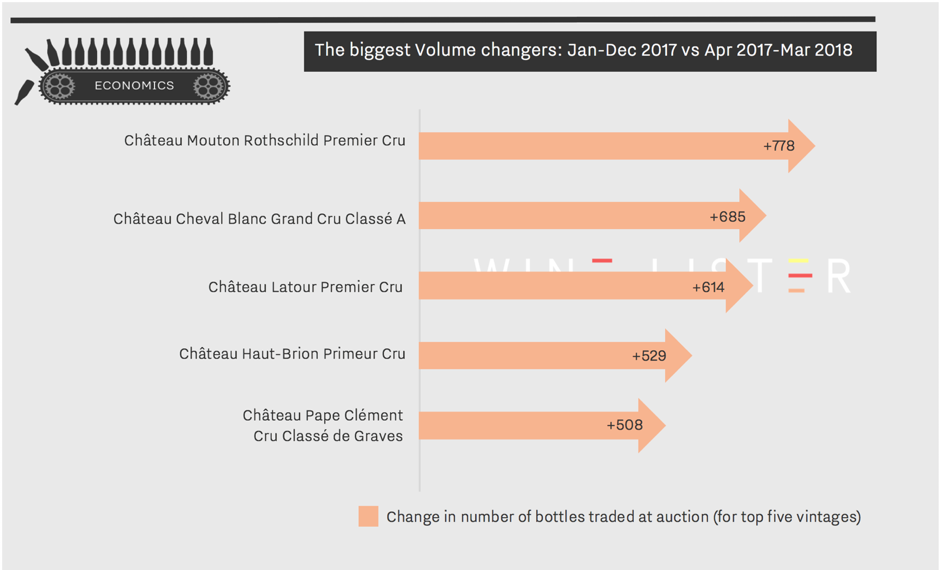
The wine experiencing the biggest increase in trading volumes is Mouton Rothschild, with 778 additional bottles traded. It has the highest Economics score of the five (956) and a compound annual growth rate (CAGR) of 11.3%. Kicking off the first growth releases of 2017 vintages this week, Mouton Rothschild’s 2017 UK release price sits 17% below last year’s at £360 per bottle.
In second place is right bank powerhouse, Cheval Blanc, whose trading volume increased by 685 bottles with the addition of the most recent quarter’s figures. Though second for incremental change, its total trading volume is at least 30% smaller than any of the left bank first growths.
Latour and Haut-Brion come in third and fourth place, both with 12% trading increases of 614 and 529 respectively.
Finally, trades of Pape Clément keep the Pessac-Léognan property’s red in the top five for trade increases for a consecutive quarter, with 506 more bottles traded in the current period. Despite dropping four places since last quarter’s auction volume results, Pape Clément still achieves the highest proportional change of all five wines at the top, with a 27% trading volume increase.
22 Champagnes for 2022
Considering the latest industry insights shared in our annual end of year study, Wine Lister explores an eclectic range of Champagne MUST BUYs worth celebrating. With an initial selection made by our proprietary recommendation algorithm, based on quality and value within the category, we have singled out some top picks to pop open as we ring in 2022.
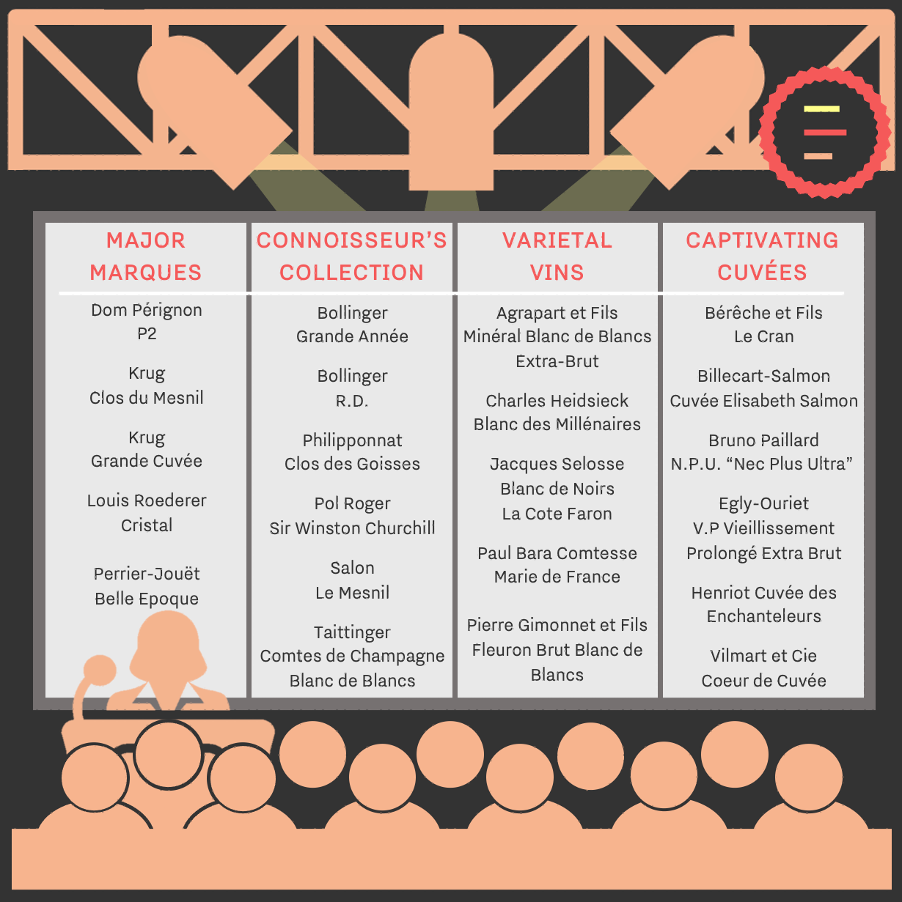 Wine Lister Leagues 2021: New Year’s Eve Champagne MUST BUYs (p. 17)
Wine Lister Leagues 2021: New Year’s Eve Champagne MUST BUYs (p. 17)
With demand for Champagne reaching record heights this year, Wine Lister’s latest Leagues explore a selection of top bottles to take you into 2022, featuring a variety of styles and price points across four categories: Major Marques, Connoisseur’s Collection, Varietal Vins, and Captivating Cuvées.
What Champagne should I buy?
Major Marques
A selection of Champagne’s strongest brands, the list of Major Marques features Krug’s Grande Cuvée and Clos de Mesnil alongside Louis Roederer’s Cristal, Perrier-Jouët’s Belle Epoque, and Dom Pérignon’s P2. The latter is considered a top Investment Staple, receiving recognition from the global fine wine market as a relatively stable and liquid option (discover our list of 2021 Investment Staples on p. 16).
Connoisseur’s Collection
Favourites among the trade and fine wine lovers alike, these insider icons include Philipponnat’s Clos des Goisses, Pol Roger’s Sir Winston Churchill, Salon Le Mesnil, and Taittinger’s Comtes de Champagne. Bollinger is featured twice in the line-up with its Grande Année and R.D. cuvées; with a distinguished history dating back to 1829, the estate has the only two vineyards in Champagne to remain phylloxera-free throughout the late 19th-century epidemic.
Varietal Vins
Our selection of Blanc de Blancs worth seeking out include Agrapart et Fils Minéral Extra-Brut, Pierre Gimonnet et Fils Fleuron Brut, and Charles Heidsick’s Blanc des Millénaires. Produced only in exceptional years, there have been four vintages of Blanc des Millénaires released since its inaugural 1983 vintage, with the cuvée spending a minimum of fifteen years maturing in the heart of Charles Heidsieck’s 2000-year-old underground chalk cellars (a UNESCO world heritage site) before release.
Made exclusively from Pinot Noir, Jacques Selosse’s La Cote Faro and Paul Bara’s Comtesse Marie de France also feature in the MUST BUY selection. A seventh-generation family business, Champagne Paul Bara is one of the few grower producers in Bouzy – a village widely regarded as amongst Champagne’s top sites for the production of Pinot Noir.
Captivating Cuvées
Sure to impress during the festive season, our list of Captivating Cuvées includes key grower producers Bruno Paillard, Bérêche et Fils, Vilmart et Cie, and Egly-Ouriet, whose featured wines each offer relative value within the selection of Champagne MUST BUYs. Henriot’s Cuvée des Enchanteleurs and Billecart-Salmon’s Cuvée Elisabeth Salmon complete the list – the latter being the only rosé Champagne featured, comprising a blend of around 50% Chardonnay and 50% Pinot Noir, of which 10% is vinified as red wine and incorporated into the final blend.
For further analysis on quality consistency, increased popularity, and a list of 2021s most compelling wines, download the Winer Lister Leagues 2021 here.
Wine Lister speaks to 10 top sommeliers to find out more about their bottles of choice
 From left to right: Lupo Theones, Victor Petiot, Gareth Ferreira, Beatrice Bessi, and Paul Lo
From left to right: Lupo Theones, Victor Petiot, Gareth Ferreira, Beatrice Bessi, and Paul Lo
What top wines do sommeliers recommend?
Whether offering the perfect food pairing or serving an unforgettable glass, sommeliers are often responsible for creating moments of vinous magic shared by wine lovers far and wide. Our latest blog flips the script, with some of the world’s leading sommeliers sharing with us their most memorable pours, providing the ultimate guide on how to drink like a pro.
Read our blog on your favourite winemakers’ favourite wine for more insight into what the experts are drinking here.
Lupo Theones – Head Sommelier at Hélène Darroze at The Connaught, London
Lupo Theones shares the same sentiment as many of his peers: “it is challenging to choose a single wine when you taste so many great wines as a sommelier”. He nonetheless mentions Egon Müller’s Scharzhofberger Riesling Kabinett 2011 as a wine that “deeply impressed” him, having tasted it soon after moving to London to join The Connaught. Describing a “perfectly balanced” palate that “shows a great acidity and minerality”, Lupo notes that it is a wine you can drink on its own, or paired with the likes of sushi and shellfish, as well as Foie Gras.
Victor Petiot – Wine Director at Caprice at Four Seasons, Hong Kong
Having discovered the vintage just last year, Victor Petiot cites Toro Albalá Don PX 1931 as his favourite wine, due to its “uniqueness” after sleeping in barrel for over 90 years. He explains that it provides “the perfect balance between powerful and well-balanced” with a “sweet and creamy texture yet high acidity”. On the topic of pairing, Victor tells us that the wine prompted the creation of a new dish to be served with it, comprising “a pigeon cooked in a coffee dough with salsify, hazelnut, pan-fried foie gras and pigeon sauce with coffee and a bit of Toro Albalá 1931”.
Gareth Ferreira – Head Sommelier at Core by Clare Smyth, London
Gareth Ferreira recalls being “immediately hooked” on his first real trip to visit the great producers of Burgundy during his early career. He tells us of the first time he tried Jean-Marie Fourrier’s Gevrey-Chambertin Clos Saint-Jacques, which made him question, “how can wine taste this good?”. It has since remained a wine he “looks forward to opening, no matter what the vintage is”, though the first he tasted – 2009 and 2010 – “will always have a special place in [his] heart” and 2002 is one of his favourites in Burgundy.
Beatrice Bessi – Head Sommelier at Chiltern Firehouse, London
“The reason that I became a sommelier is the Nebbiolo grape” exclaims Beatrice Bessi, who fell in love with Barolo in particular over 10 years ago. It is her “never-ending love”, as the region takes a lifetime to know in its entirety (“similar to Burgundy in that respect”, she notes). While citing Bruno Giacosa and Bartolo Mascarello as “traditionalist” producers that she would turn to on special occasions, Beatrice recently “fell in love with the wines of a super modern producer”, Domenico Clerico. In regards to pairing, she tells us that there is “nothing more satisfying” than an amazing glass of Barolo with pizza – there “doesn’t need to be an occasion to have a great glass”.
Paul Lo – Wine Director at Grand Lisboa, Hong Kong
Unable to choose a favourite, Paul Lo instead recalls an exclusive dinner he hosted in May 2014, at which the late chef Joël Robuchon’s menu was paired with 10 wines from the Lisboa cellar hailing from the 1959 vintage. Listing Dom Pérignon Oenothèque, Margaux, Palmer, Latour, Haut-Brion, Lafite, Mouton, La Mission Haut-Brion, Cheval Blanc, and a Steinberger Riesling Trockenbeerenauslese, he tells us that “uncorking the wines in a single event was unforgettable”. He gives particular praise to the Steinberger, noting “so many elements inside – nectar coupled with dried nuts, dry fruits, cigar, caramel, noble spices”, presented with “delicate and perfect acidity”.
 From left to right: Stefan Kobald, Victoria O’Bryan, Julien Sarrasin, Jonathan Charnay, and Pascaline Lepeltier
From left to right: Stefan Kobald, Victoria O’Bryan, Julien Sarrasin, Jonathan Charnay, and Pascaline Lepeltier
Stefan Kobald – Head Sommelier at Pollen Street Social, London
Stefan Kobald tells us that current favourite wine is Philippe Colin Montagny 2016. Having always known of the producer, Stefan discovered this specific cuvée before the first lockdown and has been “hooked ever since”. He describes its “fresh acidity, stunning aromas of ripe apple, citrus notes of lemon peel, and grapefruit”, with a “hint of butter coming from the light oak usage”. Sharing the same philosophy for when he buys wine for the restaurant and himself, he seeks freshness and drinkability, and a wine that invites you back to take another sip – which this wine “definitely does”.
Victoria O’Bryan – Wine Director at Addison Restaurant, California
Narrating her recent encounter with Krug Clos du Mesnil Blanc de Blancs 2002, Victoria O’Bryan tells us that it made her “weak at the knees”. She explains that the wine opened up with surprising ferocity, “like a jolt of electricity giving power and lift to bright citrus tones and a stunning limestone minerality”, with an expression that was “at once creamy and piercing with layers of intensity”. When pairing a wine with “this flair of tension and drama”, Victoria would recommend pouring it alongside caviar or oysters.
Julien Sarrasin – Head Sommelier at Hide, London
“Every wine aficionado would understand the emotion I felt when I first tried this unique wine”, notes Julien Sarrasin, referring the Rhône’s renowned Reynaud family, and specifically a 2004 Rayas Châteauneuf-du-Pape. Now under the influence of the “Rayas effect”, Julien also cites a rosé called Parisy from another Reynaud property, Château des Tours – a blend of Grenache and Cinsault that provided his “most exciting experience” of rosé wine. He describes its “intense bouquet of crushed wild ripe raspberries, jammy strawberries, liquorice stick, and Mediterranean herbs”, which pairs with “intense seafood and fish dishes, as well as meat”.
Jonathan Charnay – Beverage Director at Masa, New York
Echoing Lupo Theones’s choice, Jonathan Charnay tells us that his “absolute favourite wine” is Egon Müller’s Scharzhofberger Riesling, though cites the Auslese as his top wine. He muses on its “great complexity and depth” with “intense aromas of white flowers and honey” that he immediately fell in love with when tasting with Egon Müller during a visit to the winery in 2013. While it is sweet when young, Jonathan points out that it can “age for decades, turning into a delicate elixir” with notes of “apricots, ginger and bergamot”.
Pascaline Lepeltier – formerly Managing Partner at Racines, New York
Pascaline Lepeltier informs us that if she “had to go back to a wine over and over again” it would be Benoit Courault’s Gilbourg – a Chenin Blanc from Anjou in the Loire, where she grew up. “Benoit was one of the first vignerons I met over 15 years ago” she explains, noting that her path was paved by time spent with him in his vineyards in the Coteaux du Layon. Produced with grapes from different plots on schists, Gilbourg is made organically and with minimal intervention – “a real paragon” according to Pascaline. Admiring its “tremendous” ageing potential, she notes its evolution into “the most complete, complex, powerful but ethereal Chenin”.
Explore Wine Lister’s own MUST BUYs for 2021 in our recent blog here.
The end of 2020 is perhaps reason enough to pop open a bottle of champagne. With Christmas and New Year around the corner, Wine Lister has compiled a list of 21 Champagne MUST BUYs to enjoy over the last days of this year, and into 2021. Whether you have a penchant for discovering grower champagnes, or prefer to relish in those the top Grandes Maisons have to offer; whether you enjoy the purity of a Blanc de Blancs, the balance of an assemblage, or the opulence of a Blanc de Noirs, the selection of vintage champagnes below is sure to offer guidance for any preferred style.
Find out more about our 21 Champagne MUST BUYs for 2021 below.
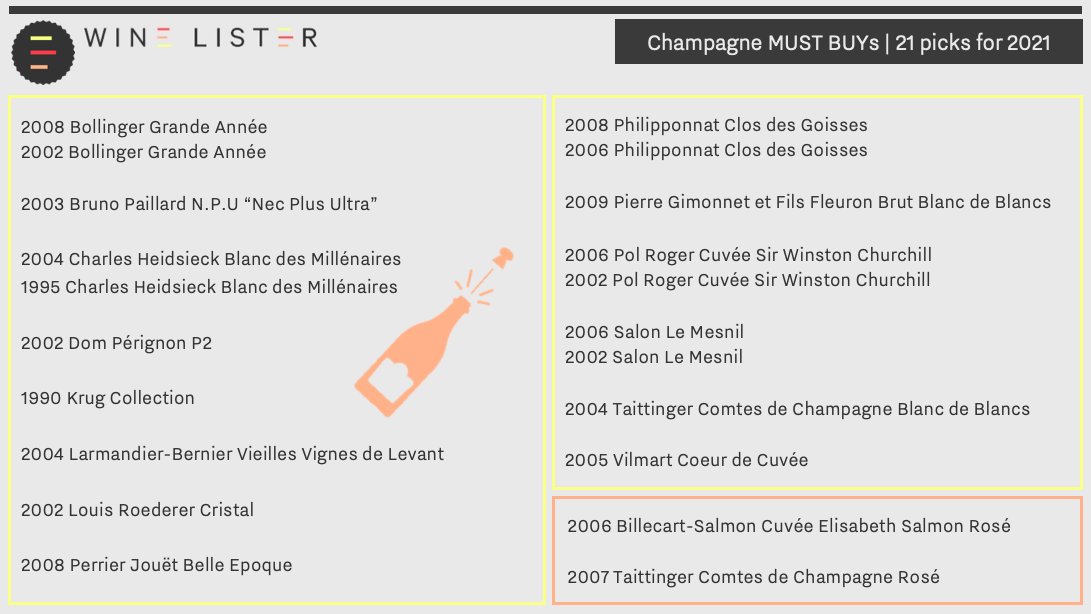
Long-established house, Charles Heidsieck, is represented in our MUST BUY selection with two vintages of its Blanc des Millénaires – 1995 and 2004. The wine is so-named to reflect its high ageing potential, and is only created in vintages worthy of the label (since its inception, just five have been made). The 2004 achieves a WL score of 95, and is praised by Wine Lister partner critic, Jancis Robinson, as having “sheer confidence, appeal and completeness”. Earning one more WL point, the 1995 shows “just how compelling this often-overlooked vintage can be”, according to Wine Lister partner critic, Antonio Galloni (Vinous). Both vintages can be bought by the case of six in-bond from Cru World Wine.
Also the crown jewel of its own house, Perrier-Jouët’s Belle Epoque carries its own portion of history within its name, referencing the Art Nouveau movement of the early 1900s. The prestige bottling can be appreciated on the inside and out, particularly in the spectacular 2008 vintage. Wine Lister tasted it recently, and found it to have a concentrated nose of white peaches, brioche, and a hint of honeysuckle, with brilliant tension on the palate. 2008 Belle Epoque is available to purchase by the bottle from Lay & Wheeler, for £129 (in-bond).
A further two MUST BUYs hail from the boutique house, Philipponnat Clos des Goisses. The 5.5-hectare Clos de Goisses parcel is the oldest and steepest “Clos” in champagne. The 2006 and 2008 vintages of this single-vineyard cuvée both receive a WL score of 96. Jancis Robinson praises both vintages, writing that the 2006 “positively screams for attention”, while the 2008 is “explosive… like a firework on the palate”. They can both be acquired in-bond from Bordeaux Index.
Included in our 21 MUST BUY champagnes are two grower offerings lying outside of champagne’s more widely-declared vintages. Notorious for its killer heatwave, 2003 is not well-appreciated among the champenois. Bruno Paillard’s 2003 N.P.U. challenges this perception, offering a “dancing” palette of “open and floral notes” according to Jancis Robinson. Acknowledging that the vintage was hugely criticised, Paillard says that for him, “it’s a great vintage”. Another elusive grower champagne rounds off our list. Jancis Robinson hailed the 2005 Vilmart Coeur de Cuvée as “a wine to wallow in”, praising its complexity and “refreshing finish”.
Also featured in the list of 21 Champagne MUST BUYs for 2021 are: 2006 Billecart-Salmon Cuvée Elisabeth Salmon Rosé, 2008 Bollinger Grande Année, 2002 Bollinger Grande Année, 2002 Dom Pérignon P2, 1990 Krug Collection, 2004 Larmandier-Bernier Vieilles Vignes de Levant, 2000 Louis Roederer Cristal, 2009 Pierre Gimonnet et Fils Fleuron Brut Blanc de Blancs, 2006 Pol Roger Cuvée Sir Winston Churchill, 2002 Pol Roger Cuvée Sir Winston Churchill, 2006 Salon Le Mesnil, 2002 Salon Le Mesnil, 2004 Taittinger Comtes de Champagne Blanc de Blancs, and 2007 Taittinger Comtes de Champagne Rosé
Taittinger Comtes de Champagne 2008 was released yesterday (1st October) at c.£89 (per bottle in-bond), marking one of the last 2008s from the “Grandes Maisons” to enter the market. The release has reignited discussion on the success of the vintage in Champagne, which has been declared one of the best of the decade along with 2002. Below we investigate top 2008s, and where the latest addition from Taittinger fits within them.
Characterised by a consistent, dry, and cool growing season, climatic conditions in 2008 encouraged slow veraison across Champagne, which enabled grapes to achieve their full phenolic maturity while retaining acidity. The combination of both gives the vintage considerable ageing potential, and unyielding structural integrity.
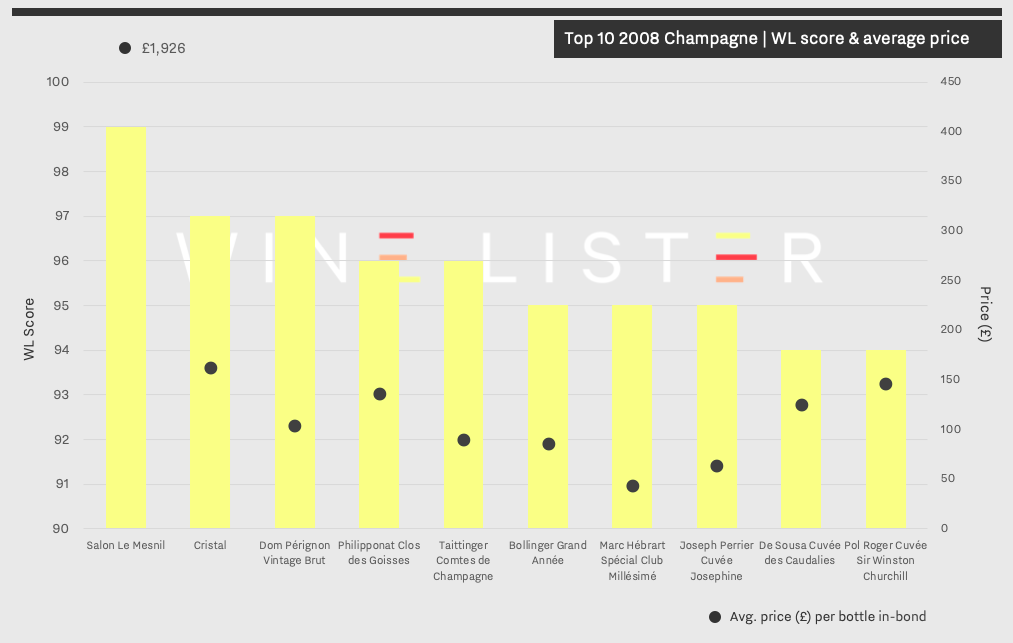
As illustrated above, the top 10 2008 champagnes by WL score exhibit impressive quality, with the top three wines gaining scores of 97 and above. This has not been achieved in the past four vintages, with Krug Brut Vintage 2003 being the most recent back vintage of a champagne to achieve a WL score of 97. Indeed, the top 10 champagnes gain an average WL score of 95.8 in 2008, compared to an average of 94.6 across the top 10 champagnes from the previous vintage.
The newest addition to the top 10 haul, Taittinger Comtes 2008 shows good value within the wider context of the vintage, despite entering the market at a 26% premium on the current market price of its 2007 vintage. While achieving the same WL score as MUST BUY Philipponat Clos des Goisses 2008 (96), Taittinger’s latest release is available for 34% less, (£89 vs. £135 per bottle in-bond). Similarly, it achieves one more WL point than Bollinger Grand Année 2008 (available for £85 per bottle in-bond), for a very slight premium.
Wine Lister partner critic, Antonio Galloni awards Taittinger Comtes de Champagne 2008 98+ points, stating it “is simply breathtaking” and “represents the purest essence of the Côtes des Blancs in a great, historic vintage”. He concludes, “readers who can find the 2008 should not hesitate”.
Taittinger Comtes de Champagne is historically one of the top 10 most liquid champagne brands, giving it further investment appeal. Additionally, Taittinger announced that it has not produced any 2009, 2010, or 2011 Comtes de Champagne, due to poor weather conditions during these years – a fact that may well increase interest in this latest release.
Also featured in the list of top 10 2008 Champagnes by WL score are: Salon Le Mesnil, Cristal, Dom Pérignon Vintage Brut, Marc Hébrart Spécial Club Millésimé, Joseph Perrier Cuvée Josephine, De Sousa Cuvée des Caudalies, and Pol Roger Cuvée Sir Winston Churchill.
In 2004, WL partner critic Jancis Robinson published an article, “Pink champagne – fashionable but too often dire”, whose title summarises the contemporaneous consensus surrounding rosé Champagne. Long-regarded by Champagne producers as a subsidiary wine – one without the required levels of attention placed on their primary project – its quality often fell short.
15 years later, in September 2019, Robinson conversely wrote a piece titled “Pink champagne – a serious wine now”, outlining the attentive methods of production, and the consequential calibre of rosé Champagne amongst its top producers.
This week’s blog post investigates the victorious return of rosé Champagne, as we examine the upward quality and price trends across 10 of its top brands when compared to their white counterparts.
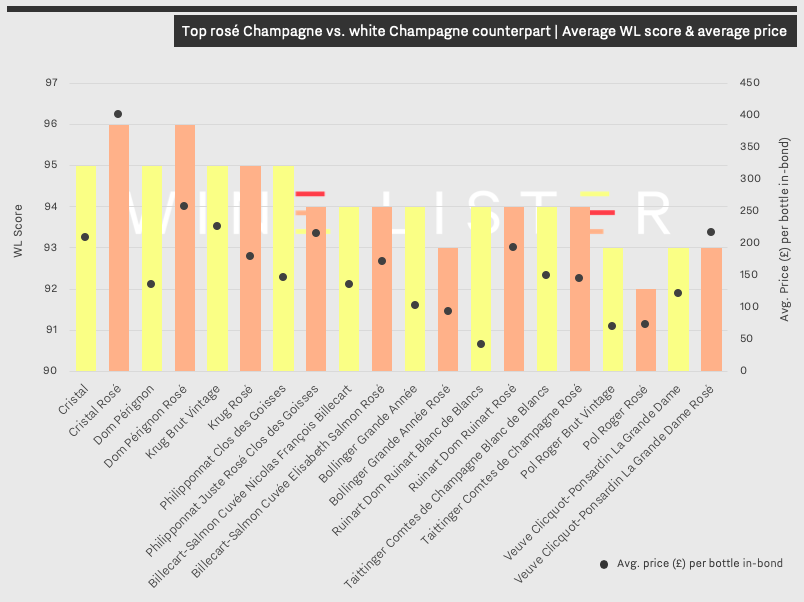
The chart above shows the average WL Score and average price for “pairs” of wines from 10 top rosé Champagne producers whose range includes a rosé.
An initial look at the selected wines reveals the recurrent pattern of rosé Champagnes costing more than their white counterparts, with the exception of Krug Rosé, Bollinger Grande Année Rosé, and Taittinger Comtes de Champagne Rosé. The mean price difference between the two styles of the respective wines is substantial nonetheless, with rosé Champagne costing 46% more on average than its white equivalent (an average of £195 for rosé and £134 for white).
Excluding Pol Roger’s Rosé and Bollinger’s Grande Année Rosé (whose white equivalents supersede them by one WL point), the rosé Champagnes featured above achieve equivalent or higher WL Scores than their white counterparts.
Cristal Rosé is a blend of 55% Pinot Noir and 45% Chardonnay grapes. With a WL Score of 96, at an average price of £401 (per bottle in-bond), this wine is almost double the price of Cristal, which has a WL Score of 95 at £203. Consequential of the generally lower yields of Pinot Noir in continental conditions, Cristal Rosé is Louis Roederer’s rarest and thus most expensive wine, produced solely in years when the grapes have attained perfect maturity.
Similarly made in only exceptional vintages, Dom Pérignon Rosé is considered by its producer to characterise its growing year, hence the fluctuating ratio of Pinot Noir and Chardonnay grapes from vintage to vintage. With a WL Score of 96, at an average price of £277 (per bottle in-bond), Dom Pérignon Rosé is over double the price of its white counterpart. Dom Pérignon Vintage Brut has an average price of £131 and has one less WL Score point than its corresponding rosé wine.
As indicated by its Vintage Value Identifier chart, the 2002 Dom Perignon Rosé exhibits significant quality and value, with a WL Score of 98. Jancis Robinson awarded this wine 20/20 (a rare occurrence), describing it as “pungent and composed with massive energy” – a far cry from her 2004 article. Rosé Champagne has most definitely made a comeback.
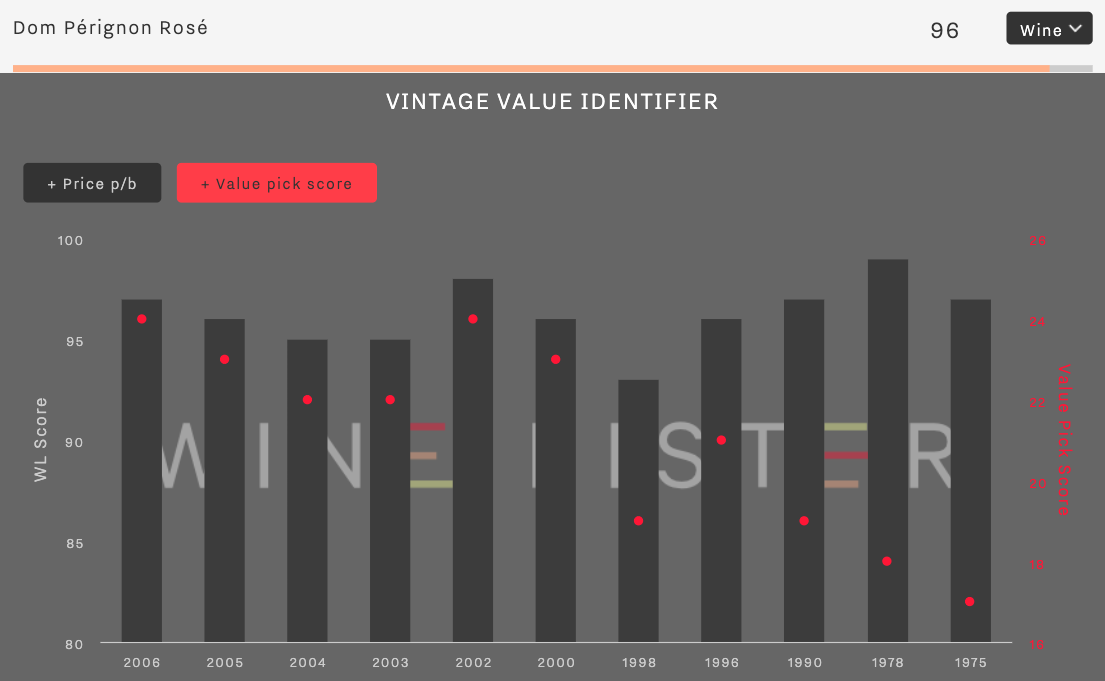
The 2002 Dom Pérignon Rosé can be purchased from Berry Bros & Rudd, where a case of three starts at £1,200 (in-bond).
At the end of last year, Wine Lister released its first ever Champagne report. As well as exploring a handful of key trends as identified by Wine Lister’s Founding Members, the report also sheds light on top Champagnes as compared to other regions in terms of economic performance.
Prices of the top Champagnes (Dom Pérignon, Krug Vintage, Louis Roederer Cristal, Salon Le Mesnil and Dom Pérignon Rosé) have seen a compound annual growth rate (CAGR) of 4.8% over the last six years. Relative to other major fine wine regions, this long-term growth is slow, as shown in the chart below, but also stable.

One notable advantage of Champagne as an investment option it its low volatility. Indeed, Champagne prices show a much better level of stability in the secondary market (deviating by just 2.5% from the average price over 12 months) than any other major fine wine region. Slow and steady wins the race.

Moreover, recent price performance shows Champagne accelerating. Prices of top Champagnes are starting to grow at a faster rate than their counterparts in California, Bordeaux, and Tuscany, beaten only by Piedmont and the seemingly unmatchable Burgundy. Indeed, as of December 2018 top Champagnes had seen a 12-month price growth of 11%. The region’s potential for long-term investment is already being acknowledged by the trade, with one of our Founding Members, a top tier UK merchant commenting “Champagne (Salon especially) has experienced solid growth and has become a reliable investment for collectors”.
Salon Le Mesnil is the number one performing Champagne for price performance, with an Economics score of 978, closely followed by Krug’s Clos d’Ambonnay (962). Krug also tops the Champagne Economics charts with its Clos du Mesnil, Brut Vintage, and Collection. Interestingly the only NV Champagne to appear within the top 10 Champagnes for Economics is grower Jacques Selosse’s Brut Initial, with an Economics score of 911. Its price, £106 (per bottle in-bond), is a mere 18% of the average price of the other nine top Champagnes by Economics score.
To read more key findings from our in-depth Champagne study, read the free summary here. (The key findings and full study are also available to download in French on the Analysis page.)
In honour of Lunar New Year, Wine Lister decided to examine wines with the strongest restaurant presence across parts of one of the major fine wine markets of today. Analysing presence in the best restaurants of mainland China, Hong Kong, Singapore, and Taiwan, the resulting top wines prove to be appropriate for this year of the pig – a Chinese symbol of wealth or fortune. The 12 wines (in this lunar year of the twelfth zodiac animal) with the best restaurant presence in these countries achieve an average price of £407 per bottle in-bond.
Latour achieves the strongest presence, appearing in 86% of the best restaurants across China, Singapore, and Taiwan. On top of breadth, Latour also achieves depth, with an impressive average of 13.6 vintages and/or formats in each of these restaurants.
Louis Roederer’s Cristal shares the horizontal presence top spot, even beating Wine Lister’s perfect Brand scorer, Dom Pérignon – the number one wine for presence in best restaurants worldwide.
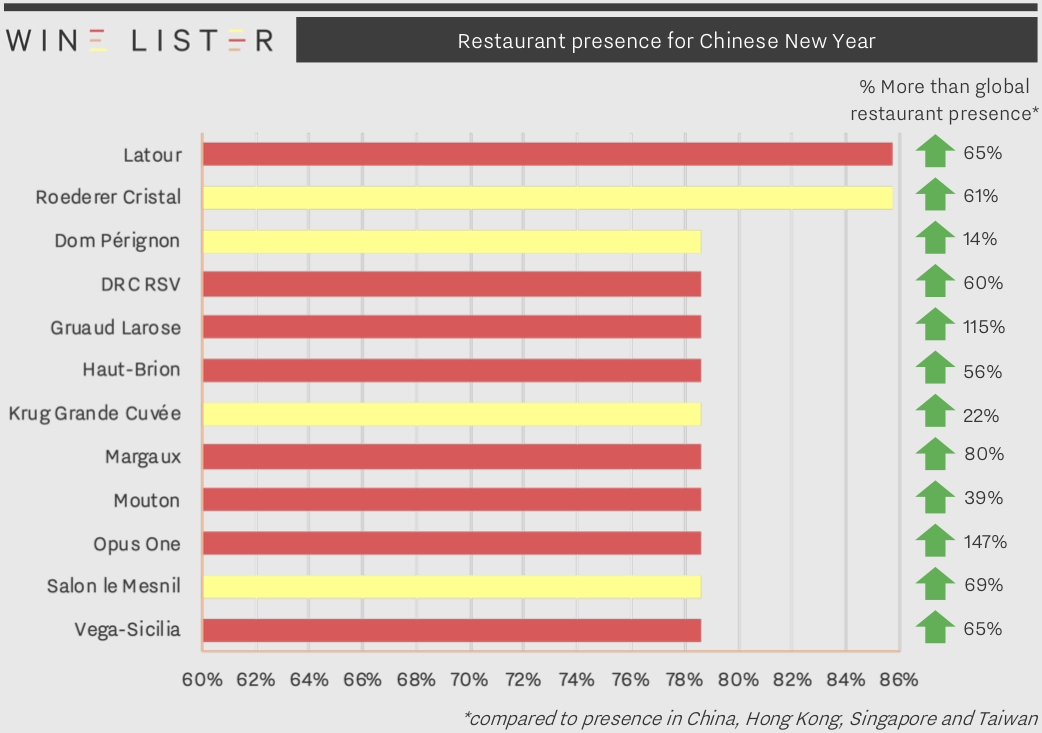
The remaining wines all achieve presence in 79% of the best restaurants across China, Singapore, and Taiwan, and make for an interesting mix of traditional candidates with some a little less expected. Perhaps the biggest surprise of all is not what appears, but what doesn’t – Lafite is conspicuous by its omission from the top 12 (with 71% presence). Though not making the top spot horizontally, Lafite does achieve vertical presence equal to that of Latour, with particular concentration in Hong Kong and Macau. The other three Bordeaux left bank first growths, Haut-Brion, Margaux, and Mouton all appear in the top 12.
Achieving the opposite effect is Gruaud Larose, the only non-first-growth Bordeaux to feature in this top-12 list. Its restaurant presence across China, Singapore, and Taiwan is an impressive 115% higher than in the rest of the world. It is also by far the least expensive of the group at £53 in-bond (over seven times less than the average price of the group).
The sole Burgundy to feature is Domaine de la Romanée-Conti’s Romanée-Saint-Vivant, achieving 60% more presence across China, Singapore, and Taiwan than its worldwide average. For vertical presence it is overtaken by a handful of its rarer siblings – La Tâche, Richebourg, and Echézeaux, which achieve a collective average depth of 5.2 vintages and/or formats.
Earning the most impressive concentration of presence compared to its global average is Opus One. It not only appears in 147% more restaurants across China, Singapore, and Taiwan than in the rest of the world, but does so with an average of 5.4 vintages and/or formats per restaurant.
Also featuring among the top 12 wines for restaurant presence in China, Singapore, and Taiwan are Krug Grande Cuvée, Salon le Mesnil, and Vega-Sicilia Unico.




 From left to right: Lupo Theones, Victor Petiot, Gareth Ferreira, Beatrice Bessi, and Paul Lo
From left to right: Lupo Theones, Victor Petiot, Gareth Ferreira, Beatrice Bessi, and Paul Lo  From left to right: Stefan Kobald, Victoria O’Bryan, Julien Sarrasin, Jonathan Charnay, and Pascaline Lepeltier
From left to right: Stefan Kobald, Victoria O’Bryan, Julien Sarrasin, Jonathan Charnay, and Pascaline Lepeltier





